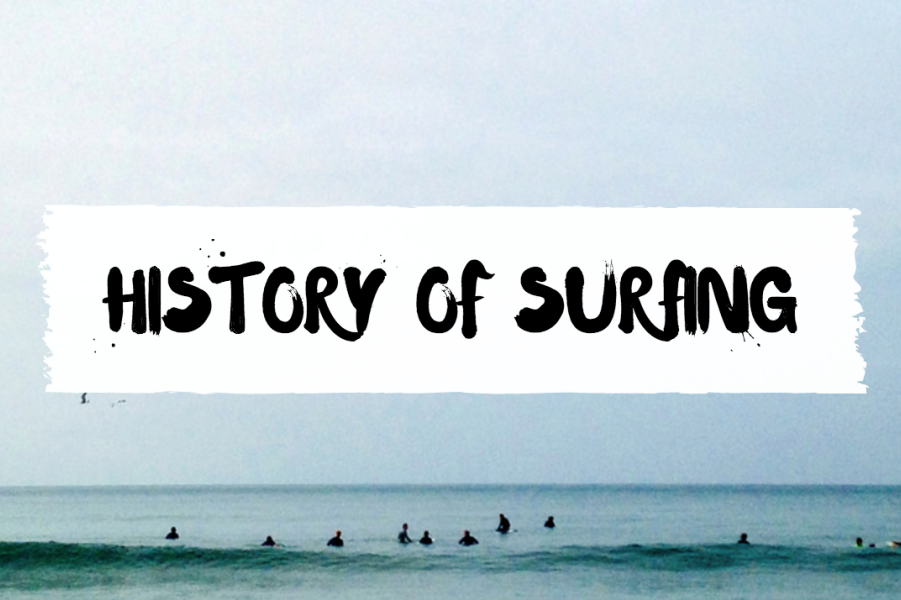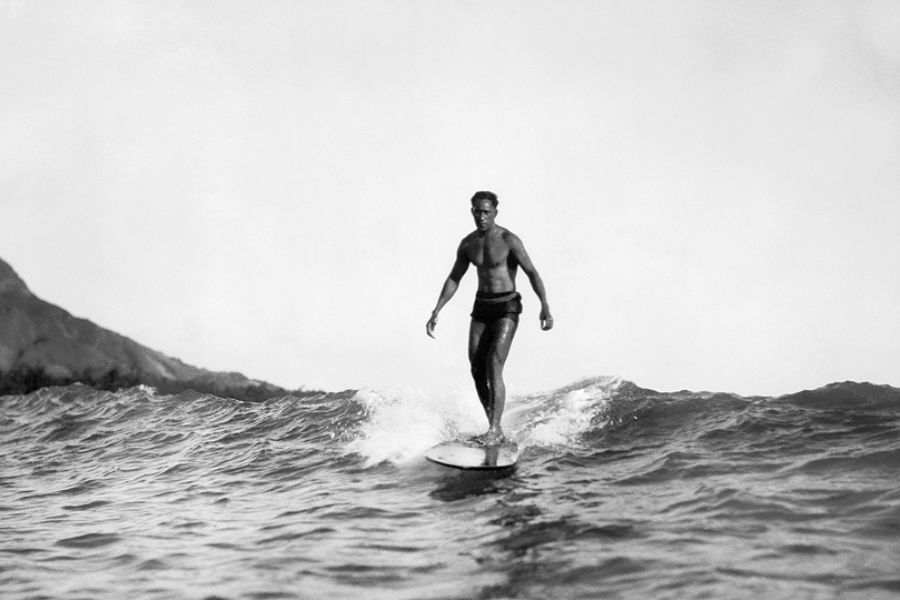
31 Dec History of surfing and first adult surf camp
History of surfing is experience of experiments of others, the line of ups and downs, that eventually turn surfing into what it is nowadays. Read this article and you will know, what the history of surfing has started from, when the first adult surf camp appeared, who were main influencers and trend setters, who have made the greatest impact into our favorite sport.
History of surfing: beginning

There are no records about first surfers, but it’s common to consider that the history of surfing has started on waves of Pacific Ocean. Some of Peruvians are sure, that their ancestors are the first generation of ocean waves conquers. They do believe that 4000 years ago on the way back from fishing trips a few men tried surfing for the first time in the history. It was pretty much a prototype of the first adult surf camp. The theory of Polynesians claims that their migration started from the island of Sumatra in Indonesia then spread to Fiji, the Marquesas Islands, and Tahiti. After all it finally has reached Hawaii. There is no doubt that surfing was created during exploring the islands of the Pacific Ocean. But here is a well-known fact: the beginning of the history of surfing takes a place in Hawaii. Hawaiians started surfing on wooden-made boards about 1000 years ago. Even the royal family and their lieges used to surf to strengthen their position and reputation. They had huge ‘Olo’ surfboards 18-25 ft long, meanwhile other people had the rights to surf only on shorter ‘Alaia’ boards.
Discovering surfing in Europe
The history of surfing in Europe started about 240 years ago, in 1779, when Lieutenant James King, who participated in the last Captain James Cook’s expedition, published excerpts of his diary. It was notes about Hawaiians life near the ocean and how joyful their beach lifestyle is. As time passed by, and Europeans began to use Hawaii as a transit spot during trade expeditions. In 1821, when the Calvinist missionaries have arrived from Britain to spread their religion among the local population, surfing was considered as a sin. According to them, local lifestyle as too frivolous, so surfing was forbidden, that practically destroyed normal routine of Hawaiians. All above this led to the point that the traditional Hawaiian culture almost disappeared. But some native Hawaiians and a few curious tourists, such as Mark Twain, who described “surf-bathing” in his book ‘Roughing It’ in 1872, pretty much saved surfing from ending up.
Surfing in XX century

The revival of surf culture started thanks due to ‘fathers of modern surfing’: George Freeth and Duke Kahanamoku. George Freeth was a member of the Waikiki beach boys band (that was sort of real adult surf camp), whose members used to surf even it was rare for that time. In 1907, Freeth met American writer, Jack London, in Honolulu 9state in Hawaii). London’s become interested in surfing and wrote an article in a magazine that made Freeth famous in the USA. Then George Freeth moved to California, where he demonstrated his surfing skills in Venice, and later on in Redonodo. By that time he’s got a nickname ‘The Man Who Could Walk On Water’. George Freeth was the first person who’s brought surfing to the mainland of the USA, but Duke Kahanamoku introduced surfing to the whole world.
Duke, as well as George Freeth, was a part of Waikiki beach boys. In 1905 he beat world swimming records, and just in 7 years he represented the American swimming team at the Olympic Games that brought him a lot of gold medals. During his travels around the world he spread a word about surfing in Australia, New Zealand and East Coast in the USA. In 1917 he surfed a big wave in Waikiki, Oahu, using a 50 kilos surfboard. On this 16 ft giant was made of a red wood he surfed almost 1,5 km at once! One of his friends, Tom Blake from California, was the first surfer, who tried surfing in Malibu (1926). Blake also was the first who organized surf competition on the USA Pacific coast. More than it, he has won, getting the best score with his self-made board.
Time machine: surfboards back in time

Hawaiians used to ride boards made from a single wood piece of different breeds: pine, mahogany or balsa. These surfboards were pretty heavy, had no fins and it was uncontrollable surf large waves, however, this was not even required, because back in the days everyone just surfed straight. In early 30s of XX century Tom Blake created surfboard called ‘cigar box’. It was a hollow construction of balsa, frames, dowels, waterproof glue and varnish. ‘Cigar boxes’ were lighter, more surfable, but still hard to control. More than above, all surfboards used to be easy-to-slip-off waves, that are bigger than 6 ft. Later on, in 1937, one teenager from Hawaii restyled bottoms shape near a tail to a V-shaped one. That helped surfers to do more rough turns. After the II WW two surfers from California started making boards with a big fin and fiberglass coat.
First official surf spots
Makaha – the first popular spot ever

In the start of last century most part of surfing was concentrated in the south of Oahu around Waikiki. The better surfboards were becoming, the more surfers were looking for better and harder waves. That’s how Makaha was discovered by 2 curios surfers in 1937, which were camping there on the beach. And the next morning woke up next to reef break and big waves. Surf there is good only when swell is up to 10+ ft, that’s why waves can be about 20 ft only few times a year.
After a break during The II WW surfing came back with new faces, one of them was George Downing, who approached the sport from the scientific point of view. When there was a swell, Downing measured time between waves, number of waves in one set, pause between sets, swell sizes in a certain period of time. When it was flat, he used to go for a swim with a mask, exploring the bottom. After all his knowledge he invented 10 ft longboard with a big fin. This board was the best for surfing big waves of Makahi. But as we said before good waves come not too often here so big waves surfers had to explore more breaks and they went to the north.
North shore

North shore history of surfing starts in 1943 from Sunset beach in Oahu and unfortunately from a tragic story. Two surfers came across to the north shore when a swell was big, but lots of foam and very strong rip currents didn’t let them to paddle back. So they decided to paddle towards to Waimea bay, but one of them has got fatality wipe out during a big set of waves. Only 15 years later 1 adult surf camp cosisting of 4 men braved to go there and Pat Curren’s become the first person surfed there! After all, the north shore has become world famous and Waimea bay is the most popular spot around.
Coming from undergound

Till the end of 50-s surfing was a part of something unknown and weird, but after dut a book and a movie ‘Gidget’ the history of surfing started being popular. ‘Gidget, The Little Girl With Big Ideas’ is a novel written by Frederick Kohner in 1957. He found his inspiration watching his daughter Katy surfing in Malibu. In 1959 Columbia pictures got rights to make a movie based on the book. Movies were pump up with ecranisation. Success of the movie led to a lot of many other surf movies, which immediately got their followers. The influence of the film and the book couldn’t been underestimated due to his input in surfing, its culture and history. According to roughs, the number of surfers only in California increased from 5,000 in 1956 up to more than 100,000 in 1962! Surf music also has had an influence on the history of surfing. The first surf songs you could listen from movies, but later on appeared surf music bands like Beach Boys, Jand and Dean, Dick Dale and Del Tones. The whole surf culture and opportunities for development of commercial have been started. In the end of the 60-s was made the first 6 ft shortboard, that were more speedy and maneuver. That is exactly how brands like Billabong, Quiksilver and O’Neill have become #1s in Australia. Jack O’Neill has made a great input in the history of surfing, when he’s created the first wetsuit. Since then surfers weren’t limited by temperature of water. Adult surf camp an industry expended their facilities and started providing lessons for kids and teens.
Surf competitions

Before 1976 there were only few local comps in USA, Australia, Brazil and South Africa. Among it the main ones were Smirnoff Pro, Duke Kahanamoku and Pipeline Masters with total prize like 10 000 USD. ISP organization united them in 1976, that can be considered as a start of ASP – Association of Surfing Professionals. Australians won most of competitions: Peter Townend’s got the first world title, Wayne Bartholomew’s got it 2 years later and Mark Richards, who’s been #1 for 4 times! Due to these legendary men, in 1984 surf contests turned into 20 comps around the world. Few years later amount of contest were increased up to 60, and in 1992 ISP was renamed to ASP. ASP introduced a two-round system of ratings for athletes. It included TOP 44 surfers who didn’t have to go through QS (Qualifying Series) and gave opportunity to new 16 surf stars who had to compete with each other in QS.
Over time, the world tour has slightly changed. Up to this point, its stages have been held in big cities in the middle of summer, mainly with an aim of collecting a large number of spectators. But at the summer time conditions on surf spots weren’t the best. As a result, the fast growing surf industry with influence of popular sponsor insisted on holding the competitions on the best surf spots around the whole world, not only selected spots. Then G-Land in Indonesia, J-bay in Africa, Mundaka in Spain, Tayarua in Fiji, Teahupoo in Tahiti and Trestles in California were included in the world tour. The President of ASP Wayne ‘Rabbit’ Bartholomew made his input in association, rebuilding score rating and creating live streaming, so wherever you are you can watch any comp. Nowadays ASP renamed to WSL (2015) and its main names are Kelly Slater, John John Florence and Mick Fanning are considered as the best surfers. But who knows, who is going to rock it in upcoming year? : )
Please rate this article! Was this article helpful? [kkstarratings]



